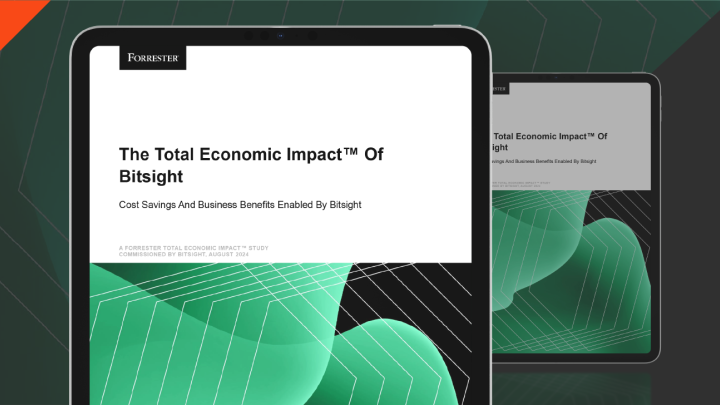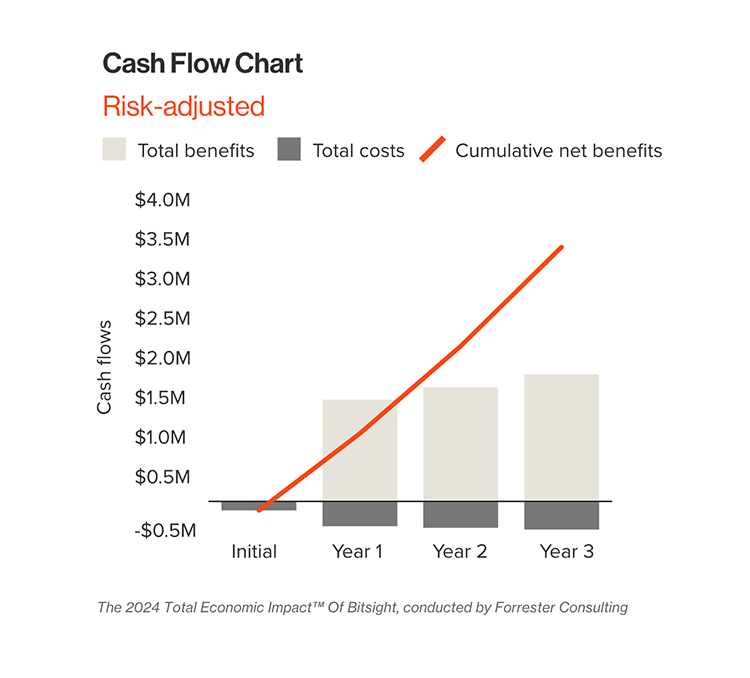Forrester TEI Study: The Story Behind the Savings
Tags:


Organizational cyber risk is notoriously difficult to quantify. Determining the impact of investments made by cyber security teams to reduce it is even tougher.
We recognize that deploying any investment in people, process, or technology, including Bitsight, comes with a cost that must be measured and justified. To help organizations considering Bitsight simplify this process and understand potential outcomes, we commissioned Forrester Consulting to conduct a 2024 Total Economic Impact™(TEI) Of Bitsight study. This research explores the financial impact that a typical organization can achieve with Bitsight, drawing on attested experiences of actual Bitsight customers. The findings are accompanied by an interactive calculator that allows you to calculate a more precise outcome for your own organization.
We encourage you to read the study and experiment with the calculator to gain a more complete understanding of the research and how to apply it within your own organization. To get you started, we have summarized some high-level factors that helped Bitsight customers achieve a measurable economic impact.
Key takeaways from Forrester's TEI Study on Bitsight
- Forrester conducted in-depth interviews with Bitsight customers and used these insights to develop a composite company for analysis.
- Based on the Bitsight impact areas that were identified and measured, the composite organization achieved a 297% return on investment (ROI).
- The composite organization also achieved a payback on their investment in Bitsight in just six months.
- The Bitsight initiative that was modeled generated a net present value (NPV) of $2.98 million over a three-year period.
- In addition to the quantifiable economic impact, there are numerous areas of qualitative impact that the researchers identified.
Understanding customer challenges and organizational characteristics
Forrester interviewed five individuals from across four organizations that are using Bitsight actively today. These interviews helped the researchers key in on common challenges, organizational characteristics, and possible areas of financial impact with Bitsight.
Based on these conversations, Forrester developed a composite organization with 25,000 employees and an annual revenue of $10 billion to use as the basis of their analysis. Of course, many areas of impact measured in the study apply to organizations larger or smaller than this. Employing interactive calculator can help you tailor a more precise estimate of the potential impact for your organization.
Some of the most relevant customer challenges identified during the interview process included:
- Lack of visibility into third-party and first-party risks
- Manual and cumbersome onboarding and monitoring processes for vendors
- Difficulty in communicating cybersecurity priorities to executives
- Challenges keeping up with changing regulatory requirements
- Managing complex risks across an expanding attack surface - including extended supply chain risk
Since these are all areas that Bitsight can positively impact, they helped frame the TEI analysis.
Quantifying Bitsight’s economic impact
Based on the insights gained from talking with Bitsight customers, Forrester focused their calculations on the following areas:
Risk Reduction: Bitsight’s external attack surface management and third-party risk management capabilities can reduce the risk of both first-party and third-party breaches by helping organizations eliminate visibility gaps and approach risk reduction more systematically. Applying this impact to the composite organization produced an estimated 45% reduction in the likelihood of experiencing a breach, which translated into significant cost avoidance. This impact alone was estimated to produce a financial benefit of $2.3 million over three years.
Third-Party Risk Management Efficiency Gains: Bitsight simplifies the traditionally cumbersome process of onboarding and monitoring the security diligence of third-party vendors. By reducing manual tasks and enabling automation, the composite organization was projected to reduce vendor onboarding time by 70% and ongoing monitoring time by 30%. This translated into $957,000 in savings over the three-year period.
Streamlined Attack Surface Management: Bitsight’s capabilities in identifying and managing external vulnerabilities led to a projected 20% reduction in the time spent on managing these issues. This time savings resulted in a financial benefit of $734,000.
Reporting and Compliance Efficiencies: Bitsight also streamlined compliance and executive reporting, saving up to 40% of employee hours previously spent on these activities. This resulted in an additional $32,000 in financial benefits for the composite organization.
Forrester’s analysis concluded that, based on these areas of impact, the composite organization achieved a net present value (NPV) of $2.98 million over three years, with an ROI of 297% and a payback period of just six months. We believe this demonstrates how Bitsight reduces cybersecurity risk and strongly justifies the financial investment when implemented effectively.

Looking beyond the numbers
While the quantitative benefits identified are substantial, the TEI study also revealed other impacts that, while remaining difficult to quantify, clearly contribute to greater operational efficiency and a stronger overall security posture.
These include:
Executive Buy-In for Security Initiatives: Bitsight’s ability to distill complex cybersecurity measurements into an easy-to-understand rating allows executives without technical expertise to make more informed decisions about cybersecurity priorities. This increased visibility and alignment at the executive level is critical for securing necessary investments in security initiatives and fostering a culture of cybersecurity awareness.
Enhanced Scalability: Bitsight enables organizations to scale their cybersecurity efforts more efficiently as they grow. This is particularly valuable for businesses that needed to monitor an increasing number of vendors and digital assets without a proportional increase in security spending.
Cyber Insurance Cost Savings: Bitsight can often be used to justify reductions in cybersecurity insurance premiums. By demonstrating a proactive risk management approach to underwriters, organizations may be able to either maintain their premiums, reduce them, or limit the size of an increase, representing a significant cost-saving opportunity in the long run.
While it’s difficult to project exact financial impacts in these areas, they are key contributors to both cybersecurity resilience, operational efficiency, and cost-effective scaling.
Performing a TEI calculation for your organization
In times of increasing budgetary pressure, every investment that organizations make, including adopting Bitsight, must demonstrate a clear return. We hope that the Forrester TEI of Bitsight study and calculator make it easier for you to develop a quantifiable, cost-effective plan for impacting risk within your organization.
Better quantify the impact of Bitsight for your organization today by:
Reading the full Forrester TEI study to gain a deeper understanding of how Bitsight can impact your bottom line.
Using the interactive calculator to estimate tailored economic impact projections for your organization.
These resources will help you understand – and demonstrate to others – how your investments in implementing Bitsight solutions can translate into positive financial impact for your organization.
 Download your copy of the Forrester TEI Study today!
Download your copy of the Forrester TEI Study today!